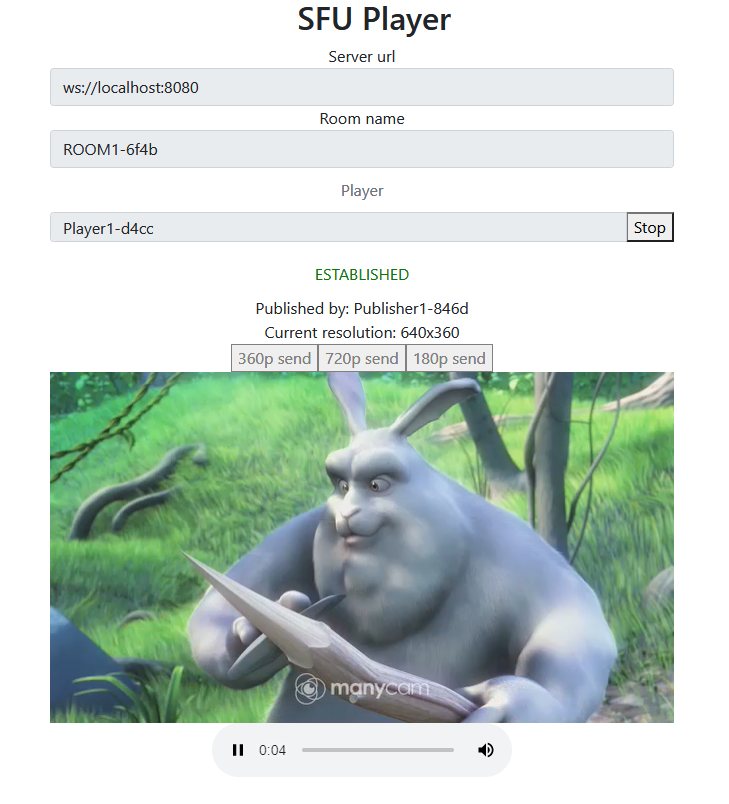...
The example shows how to play a number of streams in one WebRTC connection with simulcast. A room is considered to be a publishing unit, that is, viewers who connect to this room receive all the streams published in it.
On the screenshots below:
- Server url - Websocket URL of WCS server
- Room name - room name
- Player - viewer user name
- 360p, 720p, 180p send - quality switch buttons
Note that audio tracks are playing in a separate audio tags.
Example source code
To analyze the example source code, take the version available here, which can be downloaded with build 1.0.1.36
The source code consists of the following modules:
- player.html - HTML page
- player.css - HTML page styles
- player.js - main application logic
- config.json - client configuration file, contains streams publishing description
...
Analyzing the code
To analyze the example source code, take the file player.js version with hash 7bd8412 available here, which can be downloaded with build 1.0.41
1. Local variables
Local variables declaration to work with constants, SFU SDK, to display video and to work with client configuration
| Code Block | ||||
|---|---|---|---|---|
| ||||
const constants = SFU.constants; const sfu = SFU; let mainConfig; let remoteDisplay; let playState; const PLAY = "play"; const STOP = "stop"; const PRELOADER_URL="../commons/media/silence.mp3" |
2. Default configuration
Default room configuration to use if there is no config.json file found
| Code Block | ||||
|---|---|---|---|---|
| ||||
const defaultConfig = {
room: {
url: "ws://127.0.0.1:8080",
name: "ROOM1",
pin: "1234",
nickName: "User1"
}
}; |
3. Object to store current publishing/playback state
The object should keep Websocket session data, WebRTC connection data and room data, and shoukd form HTML tags ids to access them from code.
| Code Block | ||||
|---|---|---|---|---|
| ||||
const CurrentState = function(prefix) {
let state = {
prefix: prefix,
pc: null,
session: null,
room: null,
set: function(pc, session, room) {
state.pc = pc;
state.session = session;
state.room = room;
},
clear: function() {
state.room = null;
state.session = null;
state.pc = null;
},
buttonId: function() {
return state.prefix + "Btn";
},
buttonText: function() {
return (state.prefix.charAt(0).toUpperCase() + state.prefix.slice(1));
},
inputId: function() {
return state.prefix + "Name";
},
statusId: function() {
return state.prefix + "Status";
},
formId: function() {
return state.prefix + "Form";
},
errInfoId: function() {
return state.prefix + "ErrorInfo";
},
is: function(value) {
return (prefix === value);
}
};
return state;
} |
4. Initialization
init() code
The init() function is called on page load and:
- initializes state objects
- reads
config.jsonfile or default configuration - initializes input fields
| Code Block | ||||
|---|---|---|---|---|
| ||||
const init = function() {
let configName = getUrlParam("config") || "./config.json";
...
playState = CurrentState(PLAY);
$.getJSON(configName, function(cfg){
mainConfig = cfg;
onDisconnected(playState);
}).fail(function(e){
//use default config
console.error("Error reading configuration file " + configName + ": " + e.status + " " + e.statusText)
console.log("Default config will be used");
mainConfig = defaultConfig;
onDisconnected(playState);
});
$("#url").val(setURL());
$("#roomName").val("ROOM1-"+createUUID(4));
$("#playName").val("Player1-"+createUUID(4));
} |
...
connect(), SFU.createRoom() code
The connect() function is called by Publish or Play click:
...
- creates PeerConnection object
- cleans the previous session state displayed
- sets up room configuration and creates Websocket session
- subscribes to Websocket session events
| Code Block | ||||
|---|---|---|---|---|
| ||||
const connect = function(state) {
//create peer connection
pc = new RTCPeerConnection();
//get config object for room creation
const roomConfig = getRoomConfig(mainConfig);
roomConfig.pc = pc;
roomConfig.url = $("#url").val();
roomConfig.roomName = $("#roomName").val();
roomConfig.nickname = $("#" + state.inputId()).val();
// clean state display items
setStatus(state.statusId(), "");
setStatus(state.errInfoId(), "");
// connect to server and create a room if not
const session = sfu.createRoom(roomConfig);
session.on(constants.SFU_EVENT.CONNECTED, function(room) {
state.set(pc, session, room);
onConnected(state);
setStatus(state.statusId(), "ESTABLISHED", "green");
}).on(constants.SFU_EVENT.DISCONNECTED, function() {
state.clear();
onDisconnected(state);
setStatus(state.statusId(), "DISCONNECTED", "green");
}).on(constants.SFU_EVENT.FAILED, function(e) {
state.clear();
onDisconnected(state);
setStatus(state.statusId(), "FAILED", "red");
setStatus(state.errInfoId(), e.status + " " + e.statusText, "red");
});
} |
6. Playback start after session establishing
onConnected() code
The onConnected() function:
- sets up Stop button click actions
- subscribes to room error events
- calls playback function
| Code Block | ||||
|---|---|---|---|---|
| ||||
const onConnected = function(state) {
$("#" + state.buttonId()).text("Stop").off('click').click(function () {
onStopClick(state);
}).prop('disabled', false);
...
// Add errors displaying
state.room.on(constants.SFU_ROOM_EVENT.FAILED, function(e) {
setStatus(state.errInfoId(), e, "red");
}).on(constants.SFU_ROOM_EVENT.OPERATION_FAILED, function (e) {
setStatus(state.errInfoId(), e.operation + " failed: " + e.error, "red");
});
playStreams(state);
} |
...
playStreams(), SFURoom.join() code
The playStreams() function:
- initializes a base container tag to display incoming media streams
- joins to the room on server
| Code Block | ||||
|---|---|---|---|---|
| ||||
const playStreams = function(state) {
//create remote display item to show remote streams
remoteDisplay = initRemoteDisplay(document.getElementById("remoteVideo"), state.room, state.pc);
state.room.join();
} |
...
stopStreams(), remoteDisplay.stop() code
| Code Block | ||||
|---|---|---|---|---|
| ||||
const stopStreams = function(state) {
if (remoteDisplay) {
remoteDisplay.stop();
}
} |
...
onStartClick(), playFirstSound(), connect() code
- validates input fields
- in Safari browser, calls playFirstSound() before playback to automatically play incoming audio
- calls connect() function
| Code Block | ||||
|---|---|---|---|---|
| ||||
const onStartClick = function(state) {
if (validateForm("connectionForm") && validateForm(state.formId())) {
$("#" + state.buttonId()).prop('disabled', true);
if (state.is(PLAY) && Browser().isSafariWebRTC()) {
playFirstSound(document.getElementById("main"), PRELOADER_URL).then(function () {
connect(state);
});
} else {
connect(state);
}
}
} |
...
onStopClick(), Session.disconnect() code
The onStopClick() function:
- stops playback
- disconects Websocket session
| Code Block | ||||
|---|---|---|---|---|
| ||||
const onStopClick = function(state) {
$("#" + state.buttonId()).prop('disabled', true);
stopStreams(state);
state.session.disconnect();
} |
11. Websocket session disconnection actions
onDisconnected() code
The onDisconnected() functions:
- sets up Play click actions
- enables Server url and Room name fields access, if there's no parallel session
| Code Block | ||||
|---|---|---|---|---|
| ||||
const onDisconnected = function(state) {
$("#" + state.buttonId()).text(state.buttonText()).off('click').click(function () {
onStartClick(state);
}).prop('disabled', false);
$('#url').prop('disabled', false);
$("#roomName").prop('disabled', false);
$("#" + state.inputId()).prop('disabled', false);
} |
